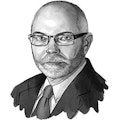We all like to be unique and special in some ways. As collision repairers, many of us strive to be better than average and some of us strive to really excel.
We purchase quality and up-to-date equipment. We educate ourselves and send our staff to training. We strive for measured high performance in terms of sales, customer satisfaction ratings (CSI), cycle time and other key performance indicators. Some of us invest a great deal of money and effort in OE certification.
Want to meet Darrell Amberson?
-
He’s leading a session at the FenderBender Management Conference Sept. 19–21 in Chicago and will be available for questions and discussion.
We not only seek the satisfaction of knowing we repair vehicles properly but also want to reap financial rewards. In fact we need to see a return on our investment to stay in business. That can come in the form of increasing our sales through improving our reputation, thus driving more work to our doors and being paid higher amounts for tasks of higher demand, such as when repairing structural damage or new materials like aluminum or carbon fiber. When it comes to our attention that our competitors don’t invest as we have, yet get similar referrals or get paid at the same rate we are frustrated, perhaps even angry. It is then that we start considering how we differentiate our businesses. We want to see some process or classification for recognizing those collision repair businesses that have better equipment, training, processes and overall performance. We want insurers and consumers and other shop operators to be able to recognize the differences.
This has been on the minds of many of us for some time. There are currently many entities that offer some form of differentiation, such as I-CAR Gold status, VeriFacts, OE certifications, insurance DRPs, paint company certifications, and some specific safety certifications. In the U.K. there is a Thatcham shop certification managed through Kitemark (similar to our UL). The Collision Industry Conference (CIC) Class ‘A’ Shop document is another tool to differentiate shops.
In my career and in companies I’ve worked with, we’ve often differentiated ourselves with high levels of education, shop certification, dealer relationships, and formal accreditation. I personally believe that high levels of shop performance have a way of offering reward in the long run, even though they require significant effort and investment.
The CIC Class ‘A’ Shop document has become very controversial within CIC in recent months. Some feel that it is not current in that a Class ‘A’ shop in today’s world should include more equipment and training.
Some feel that the OE certifications should suffice to differentiate shops and that, since the OEs set the repair standards, they too should set the shop standards. Others feel that there is value in the Class ‘A’ document as it has been used by some insurers and others to define a good shop. Some feel that, at very least, the name needs to be changed to no longer imply that the document defines the highest caliber of shops. And some feel that the document should be updated to reflect different levels of shop capabilities, such as a three-tier system that would place shops with most capabilities, in terms of structural and aluminum and high tech repairs, in the top tier.
A high quality shop without aluminum or other high-tech capabilities would presumably be in the third tier. Frankly, the CIC Definitions Committee is in the nearly impossible position of finding a solution that satisfies the CIC attendees’ majority.
Personally, I believe that more powerful ways of collision repair business differentiation are inevitable, especially thinking in terms of some sort of shop certification. Despite the fact that most of us don’t like more regulation, our desire for differentiation is so very strong. I think it’s likely we will end up with a relatively universally accepted shop certification plan.
Most of us hope that it is not a government plan. A few high profile catastrophic repair failures could lead to that. For that reason, I believe as an industry we should move toward our own plan, coming from within. Perhaps OE certifications could become more readily recognized. Perhaps a joint effort from OEs to standardize the structure and requirements could be orchestrated. Perhaps a high profile independent organization like I-CAR could make it happen. Another possibility is that a business group like VeriFacts or Assured Performance Network could gain enough market share and recognition to get the job done.
Whatever it is, those of us who strive for higher levels of performance will continue to seek ways to bring attention to those ways that we differentiate ourselves to create superior results. We have no choice considering the need for a return on our investments, as well as the necessity to offer safe and complete repairs.
About the Author

Darrell Amberson
Darrell Amberson is the president of operations at LaMettry’s Collision in the Twin Cities and a highly engaged, longtime industry volunteer and advocate. Reach him at [email protected].
